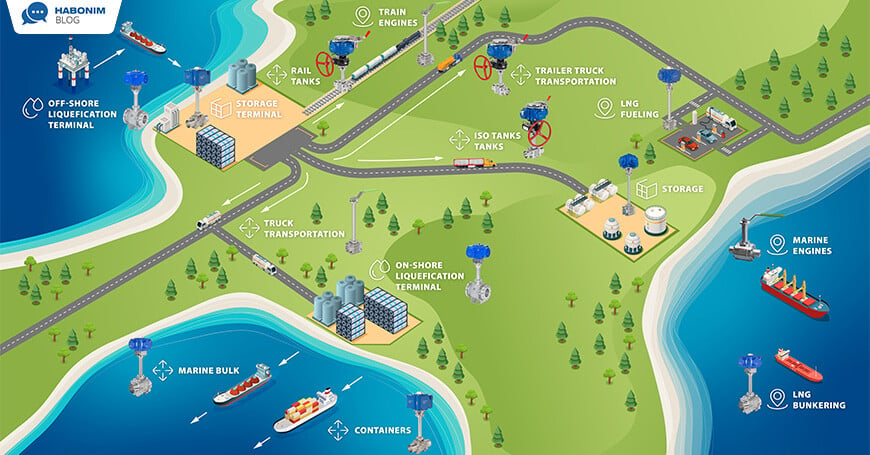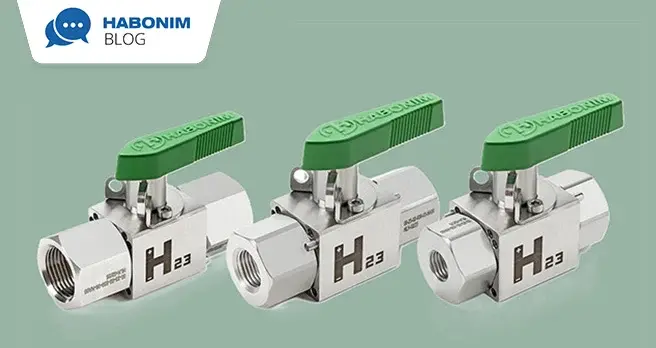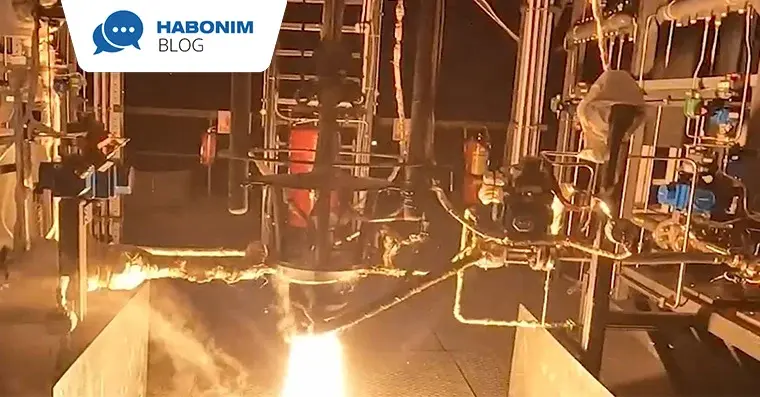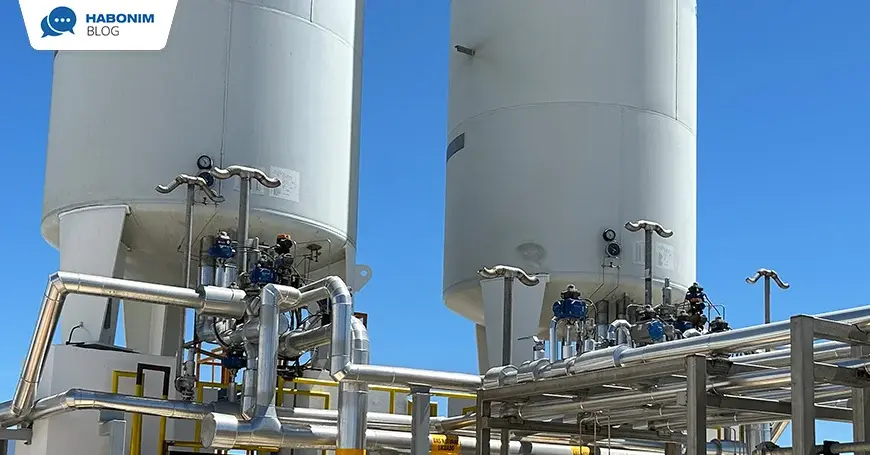Embracing LNG (Liquefied Natural Gas) opens exciting opportunities to address the challenges on the way to zero-carbon processes. The LNG supply chain involves four interconnected stages: Liquefaction, Storage, Distribution, and End-use, each presenting its own unique complexities and potential for innovation.
Let's delve deeper into each of the stages:
Liquefaction - in the production process, feed gas contains substances other than natural gas, mostly methane (CH4), which requires processing. After removing the impurities, the natural gas is ready to be liquefied. This process occurs at liquefaction plants, where the natural gas is cooled to -162°C (-260°F) to turn it into a liquid at atmospheric pressure. The pipe sizes range from 4" to 16", and the gas is cooled to low pressures close to atmospheric pressure to turn it into a liquid.
|
Installation example: Habonim had a project for a port that received natural gas, liquefied it, and distributed it to ships. The liquefaction is done locally, with pictures showing the infrastructure, and the LNG exceeds ISO containers that are transported by trucks.
|
The second stage, Storage - LNG is stored in LNG Terminals and loaded onto carriers for distribution. Sometimes, the LNG is gasified and then compressed for other uses. In such cases, Methane (CH4) compressors of various sizes may be required. These cases will require special-rated piping and valves up to Class #1,500 and Class #2,500, with pipe sizes ranging from 2" to 8". The pressures involved can range from low, close to atmospheric, and up to 250 bar /3600 psi.
LNG Use Points—In other cases, LNG is stored for shorter periods before distribution in locations closer to target industries. In this scenario, pipe sizes typically range from 1" to 8", and the pressures involved are relatively low- 15 to 40 bar (220-580 psi).
Distribution of LNG, including marine bulk, containers, and transportation by tracks/trains. LNG is transported on a large scale, usually by LNG carriers offshore or by ships, tankers, and ISO tanks on tracks or trains for inland transportation.
In Europe, transporting pressurized gas requires TPED (transportable pressure equipment directive) certification, among others, to ensure the proper functioning and integrity of the system while pressurized gases are being transported.
Containers
LNG containers are low-pressure rated and require type approval for any offshore proposals. In the case of a fueling station, normally welded valves with a pressure rating of class #600 (- up to 100 bar / 1450psi) are required, pipe sizes can range from 2" to 8".
|
Installation example: Transportable LNG Fuel Station. #600 BW Valves. The picture shows a transportable fuel station case, hence the higher pressure class.
|
ISO Tanks
ISO tanks are usually limited in space and will require an emergency shut-off device (ESD) to be installed in most, if not all, cases. Habonim's solution is the fire block valve (FBV), a short 6" bonnet valve equipped with an ESD. Typically, FBV sizes for ISO tanks range from 1" to 3".
At the end of the value chain, we reach the End Use.
LNG Fueling:
LNG fueling is quite the same as petrol fueling, except the nozzle is different, and you will need to connect the ground cable to avoid a spark resulting in an explosion. Most of the piping involved is small in diameter, 0.5"- 1", the process pressure is low - up to 16 bar, and the entire system is automatically actuated.
Fewer carbon emissions.
Bunkering:
The process of fueling a ship with LNG requires well-trained staff and strict protocol adherence to avoid accidents. The bunkering process is quite lengthy and takes between 14 to 18 hours from connection to disconnection. The bunkering line pressure is typically around 3 bar / 44 psi, and the pipes involved are between 1" and 8". Bunkering equipment, including valve commission on the receiving or bunkering vessels, requires Marine Type Approval.
|
Installation example: As a reference, we can share the work on a project, which was designed to transfer LNG inland through waterways in the Netherlands. Habonim provided 4" Full Bore Cryogenic Valves and an 8" Cryogenic Control Valve actuated by the Habonim C100 actuator, which features a 4-piston scotch yoke mechanism. As well as any offshore equipment, valves commissioned on the receiving vessel, or a bunkering vessel would require marine type approval.
|
Marine engines:
LNG-powered vessels or dual-fuel vessels typically store natural gas in liquid form and burn the boil-off gas inside the engine.
Such vessels require a pressurizing system to feed the engines and a Nitrogen purging system for line cleaning when switching from diesel to LNG fuel.
[In the right picture, you can see the custom process unit solution for nitrogen on the LNG commission fueling station for the nitrogen version.] Typically, the pipes will be sizes 1/2"-3", low and high-pressure rates (150#-2500#) for LNG. Low class for LNG fueling.
Required Certifications and Type Approval:
ATEX IIC – according to 2014/34/EU.
SIL – according to IEC 61508-1,2, 2010/35/ EU.
Fire safe – according to ISO 10497, API 607, API6FA.
Fugitive emissions – according to ISO 15848-1, API641.
Type Approval
NK/ ABS/CCS/ BV/DNV / LR
Habonim LNG Valves
Standard Offering - Certifications
TPED
Habonim LNG Valves
Fire-safe Valves with Total HermetiXTM
Double Body Sealing, HermetiX Zero Fugitive Emissions No Maintenance Stem Sealing, Fire Safe
500,000 on-off cycles w/o refurbishing ISO 15848-1 CO5 level
Habonim LNG Valves
Standard Offering
Habonim LNG valves: XX FC47W-666MAAG/BW-P250
C = Cryogenic valves, for temperatures below -55°C (-67°F).
Pressure rating: #150 to #2500 – up to 414 bar (6,000 psi).
Pressure relief mechanism: Optional in both unidirectional and bi-directional valves.
Temperatures: Down to -260°C to (-436°F).
Connections: Welded, flanged and threaded.
Sizes: wide range ½” – 12”.
Control valves: V port / ball.
Habonim LNG Valves
Bi-directional valve sealing
High Cv
Smaller valves and piping required
Smaller and simpler actuator
Lower CAPEX and total cost of ownership (TCO)
Habonim LNG Valves
Fire Block Valve
- Standalone ESD - Air supply is not required
- Automatic - Operates without human intervention
- Temperature sensitive - Fusible link unit designed to melt in the event of a fire
- Manual override (optional) - Cable-operation
- Dual system (optional) - Actuated operation
When choosing the right valve for your requirements, it is crucial to ensure your system has the necessary mechanism. Habonim offers a wide range of products to meet your needs. For expert advice and personalized consultation regarding your specific LNG Supply Chain needs, please visit Habonim's website and consult our experienced team.












